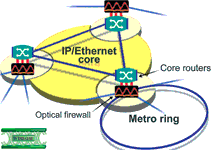
EU funding of 2 million Euros has been announced for a major new three-year project to develop a re-configurable photonic ‘firewall on a chip’. The new system is intended to plug a major gap in the global data network security armoury – the lack of tools to implement security checks and algorithms directly at high optical data communications rates.
Being developed by a consortium led by CIP (The Centre for Integrated Photonics) in the UK, the system, called WISDOM, (wirespeed security domains using optical monitoring), will complement current electronic security techniques with optical information filtering operating at wirespeed.

"Optical technology lies at the heart of the global electronic and computer-based communications systems on which we are all increasingly reliant," says Graeme Maxwell of project co-ordinator CIP. "It is the key to very high data speeds and very large information handling capacity. But we are still reliant on conventional electronic tools for key functions such as legal intercept, flow classification and performance monitoring. WISDOM technology will provide a scaleable and robust solution to key issues of next generation network security by allowing close inspection of optical data directly in the optical domain."
Technical background
The optical sub-systems being developed will take state-of-the-art hybrid integrated photonic technology and extend it to meet the performance requirements of a photonic firewall. The sub-systems will be based on the leading research on high-speed (greater than 40 Gbps) optical logic gates and optical processing circuits provided by the project partners.
Optical processing sub-modules will perform bit pattern recognition as input to a range of security algorithms, based on existing research in network intrusion detection systems. In broad terms, these algorithms use combinations of rule bases and statistical models to identify potentially interesting network events. The bit patterns that form the signature of a typical network security event might range from single bits in a packet header through to relatively long sequences of bytes in the message payload. The optical processing will be based on all-optical logic gates using semiconductor optical amplifiers (SOAs) as non-linear elements.
Further research will target effective algorithms for identifying security events. Within this platform, silica-on-silicon circuits will be used as the optical equivalent of the electronic PCB, providing the passive optical functionality, time delays and closed loop optical circuits. This optical circuit board will be populated using both discrete and monolithically-integrated active semiconductor devices. The specific choice of component will be determined by the function required and the level of maturity of the technology delivering that function. A range of optoelectronic components can be integrated, including laser sources, optical amplifiers, optical modulators and optical detectors. Passive assembly and precision alignment designs will be used throughout to establish the platform as low cost, since packaging is the dominant cost in these complex, high-performance sub-systems.
For more information contact CIP, +44 (0)1473 663210, [email protected]

© Technews Publishing (Pty) Ltd | All Rights Reserved